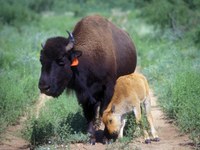Fascinating Facts
- Buffalo or bison?
- In America, “bison” and “buffalo” refer to the same animal. However, scientifically speaking, there are no true buffalo in North America. The only true buffalo are the African Cape Buffalo and the Asian Water Buffalo.
- Still endangered?
- Bison are great survivors. Although once nearly extinct, bison numbers have risen from less than 1,000 to nearly half a million! Most are part of private herds.
- Bison or supermarket?
- Bison were central to the lives of many Native Americans on the plains. It is doubtful that any other animal in the world has ever provided so many important items. Supermarkets fill that role for us today – with a lot less work on our part! The number of non-food uses of bison is as high as 87.
- Bison calves.
 Newborn bison calves are light brown to cinnamon in color. Later, they turn the darker brown of their parents. Normally, only one calf is born per year, but twins do occasionally occur.
Newborn bison calves are light brown to cinnamon in color. Later, they turn the darker brown of their parents. Normally, only one calf is born per year, but twins do occasionally occur.- A camel, a lion…no, a bison - oh my.
- A bison has a shape like no other animal. The large hump on its back is a huge shoulder muscle that holds up (and powers!) its head. The special bones that support this muscle are called the “hump ribs.” Using this powerful system, bison can “plow” through deep snow to feed on dry grass in the winter.
- Bison also communicate using a variety of sounds. Many people think the roaring, booming sounds of bison bulls sound much like a lion.
- Am I being buffaloed?
- Not at all! When early settlers saw a bison raise its tail in an “S” shape when it was very excited or agitated, they knew that it was time to get moving or “high-tail it!” If you heard the phrase “you can’t buffalo me,” someone was trying to force, threaten or manipulate that person.
